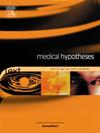糖皮质激素在中枢性浆液性脉络膜视网膜病变中的作用的完全相反的观点
IF 0.8
4区 医学
Q3 MEDICINE, RESEARCH & EXPERIMENTAL
引用次数: 0
摘要
中枢性浆液性脉络膜视网膜病变(CSCR)传统上与糖皮质激素(GC)过量有关。我们提出了相反的观点:在易感个体中,细微的下丘脑-垂体-肾上腺(HPA)轴抑制——由系统性GC暴露或适应性不良应激反应引发——降低眼内皮质醇,改变糖皮质激素/矿化皮质激素受体平衡,并驱动视网膜色素上皮-脉膜复合体中的矿化皮质激素受体(MR)过度激活。这个级联诱导脉络膜神经病变,厚脉络膜表型和视网膜色素上皮(RPE)屏障破坏。实验模型、生物标志物研究和代谢组学数据支持这一机制,解释了为什么系统性而非眼内GCs与CSCR相关。如果得到证实,这种范式转变将有利于谨慎的GC逐渐减少,局部眼部GC补充和MR拮抗剂作为靶向治疗策略。本文章由计算机程序翻译,如有差异,请以英文原文为准。
A diametrically opposed view of the role of glucocorticoids in central serous chorioretinopathy
Central serous chorioretinopathy (CSCR) is traditionally linked to glucocorticoid (GC) excess. We propose the opposite: in predisposed individuals, subtle hypothalamic–pituitary–adrenal (HPA) axis suppression—triggered by systemic GC exposure or maladaptive stress responses—lowers intraocular cortisol, shifts the glucocorticoid/mineralocorticoid receptor balance, and drives mineralocorticoid receptor (MR) overactivation in the retinal pigment epithelium–choroid complex. This cascade induces choroidal neuropathy, pachychoroid phenotype, and retinal pigment epithelium (RPE) barrier breakdown. Experimental models, biomarker studies, and metabolomic data support this mechanism, reconciling why systemic but not intraocular GCs are associated with CSCR. If confirmed, this paradigm shift would favor cautious GC tapering, local ocular GC supplementation, and MR antagonism as targeted therapeutic strategies.
求助全文
通过发布文献求助,成功后即可免费获取论文全文。
去求助
来源期刊

Medical hypotheses
医学-医学:研究与实验
CiteScore
10.60
自引率
2.10%
发文量
167
审稿时长
60 days
期刊介绍:
Medical Hypotheses is a forum for ideas in medicine and related biomedical sciences. It will publish interesting and important theoretical papers that foster the diversity and debate upon which the scientific process thrives. The Aims and Scope of Medical Hypotheses are no different now from what was proposed by the founder of the journal, the late Dr David Horrobin. In his introduction to the first issue of the Journal, he asks ''what sorts of papers will be published in Medical Hypotheses? and goes on to answer ''Medical Hypotheses will publish papers which describe theories, ideas which have a great deal of observational support and some hypotheses where experimental support is yet fragmentary''. (Horrobin DF, 1975 Ideas in Biomedical Science: Reasons for the foundation of Medical Hypotheses. Medical Hypotheses Volume 1, Issue 1, January-February 1975, Pages 1-2.). Medical Hypotheses was therefore launched, and still exists today, to give novel, radical new ideas and speculations in medicine open-minded consideration, opening the field to radical hypotheses which would be rejected by most conventional journals. Papers in Medical Hypotheses take a standard scientific form in terms of style, structure and referencing. The journal therefore constitutes a bridge between cutting-edge theory and the mainstream of medical and scientific communication, which ideas must eventually enter if they are to be critiqued and tested against observations.
 求助内容:
求助内容: 应助结果提醒方式:
应助结果提醒方式:


